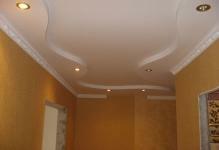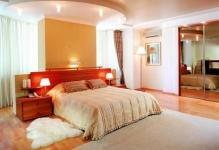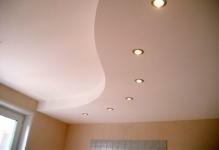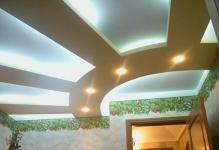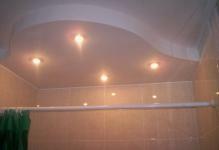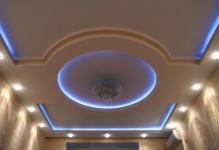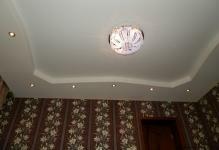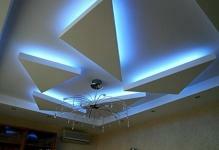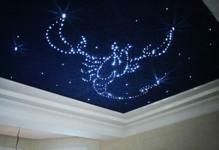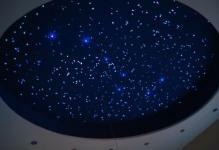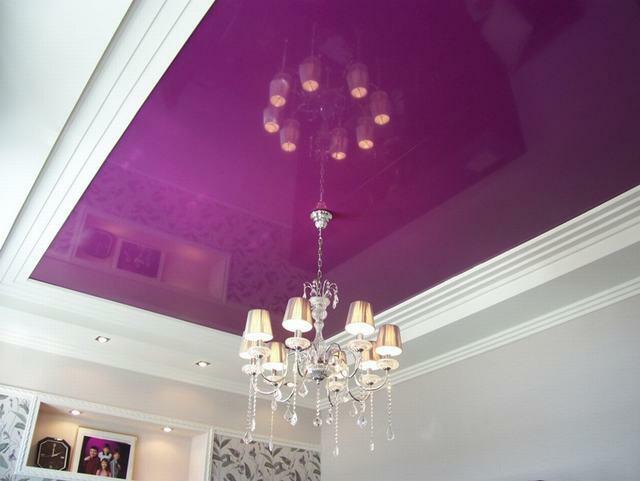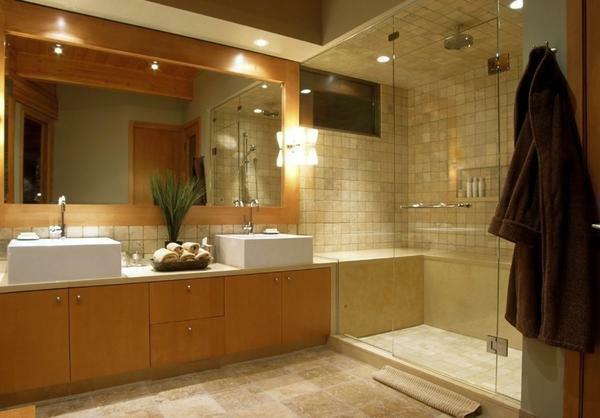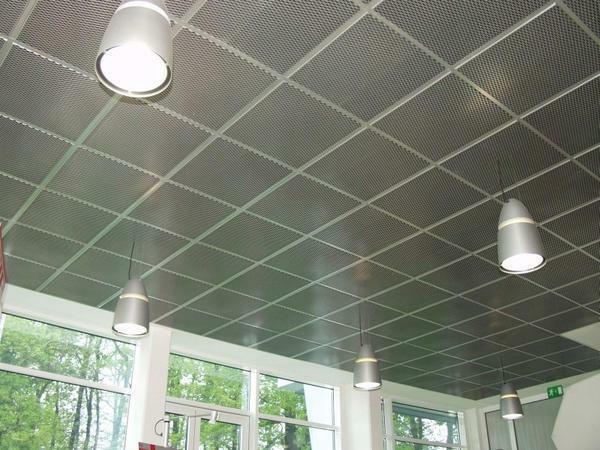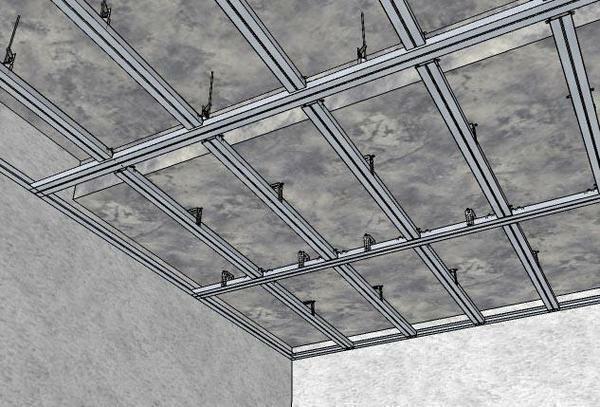 Drywall is easy to use. It can easily take the desired form for the ceiling Drywall began to be used in the 70's of the last century. Nowadays no repairs are possible without this material. Drywall is often used for finishing the ceiling, because with its help you can create even a multi-level construction. Gypsum is a filler of this material, and cardboard is the basis. Drywall has a smooth structure, so that the sheet can easily be shaped into any shape.
Drywall is easy to use. It can easily take the desired form for the ceiling Drywall began to be used in the 70's of the last century. Nowadays no repairs are possible without this material. Drywall is often used for finishing the ceiling, because with its help you can create even a multi-level construction. Gypsum is a filler of this material, and cardboard is the basis. Drywall has a smooth structure, so that the sheet can easily be shaped into any shape.
-
- The main types of ceilings from plasterboard
- We are assembling a caisson ceiling from gypsum board
- What is the best drywall for ceiling finishing
- How to make a starry sky on a gypsum board ceiling
- Thickness of a plasterboard for a ceiling( video)
- Thickness of plasterboard for ceiling( photo)
Main types of ceilings from plasterboard
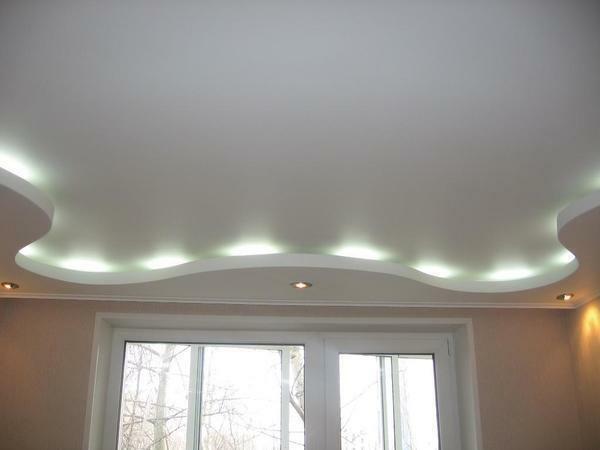 Multilevel ceiling from gypsum board will nicely decorate inTerrier of your room
Multilevel ceiling from gypsum board will nicely decorate inTerrier of your room
What types of ceilings exist?There are 3 types of gypsum plasterboard structures: one-level, two-level and three-level. Also there are models with a complex configuration.
Single-level ceilings consist of:
- Frame. It is made of metal, and is attached to the bearing wall.
- Plasterboard plating.
- Fixtures.
A single-level system is often used as a basis for a more complex design. This system helps to hide the unevenness of the ceiling and is ideal for finishing small rooms.
Two-level and three-level systems can have different configurations. They are used for finishing large rooms. Such systems can have the configuration of an oval, a square or a rectangle.
There are 3 types of two-level and three-level systems:
- Diagonal. Such a ceiling is installed on a single-level system or a conventional ceiling made of concrete. The planning of this type is used in case you need to achieve a visual highlight of any part of the room. For example, diagonal ceilings can be used to divide between a rest area and work.
- Framework. This system is a corner or shaped box. Frame ceiling is often used for finishing small spaces, because with it you can achieve a visual expansion of space.
- Zone. This design can be used to frame the ceiling in the living room or kitchen. It is advisable to use the zonal system if you need to conditionally divide the room into a recreation area and work area.
Models of complex configuration are rarely used. It is advisable to use them if you want to make a multi-level construction.
We are assembling a caisson ceiling from a gypsum board
It is quite easy to assemble a caisson ceiling with our own hands. Before you begin to install the structure, you need to apply the putty on the surface. After that, proceed with the assembly of the frame.
In order to produce a quality frame, you need to apply a grid of rectangular configuration to the ceiling. The size of each cell is determined individually. When choosing the size of the cell, pay attention to the dimensions of the room.
Assemble the coffered ceiling in the following order:
- According to the marking, fix the ceiling profile to the ceiling.
- Bend the profile by cutting with metal scissors.
- After the skeleton has been made, proceed to the roof paneling. For this, fix the plasterboard sheets to the base with self-tapping screws.
- Then it is necessary to seal up the places where the fixing elements are installed, with putty.
- Next, you need to remove excess putty and apply decorative coating.
What is the best drywall for ceiling finishing?
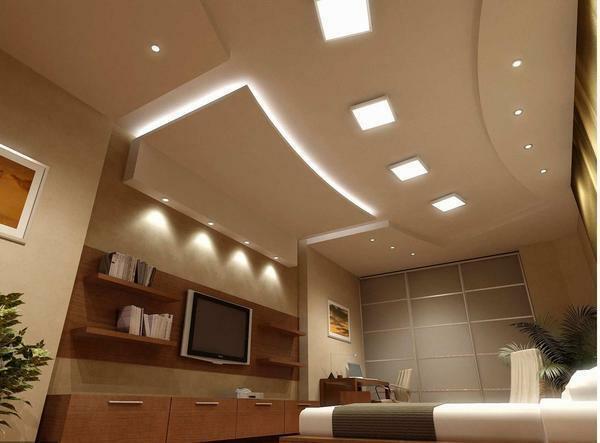 Thick plasterboard will save the ceiling from sagging in the center of the room
Thick plasterboard will save the ceiling from sagging in the center of the room
In order for the structure to be strong, you need to select the best materials. In doing so, you must take into account the features of the room. The most common material is ordinary drywall. It is advisable to use it for finishing ceilings in rooms with low moisture indices. The thickness of this material can vary.
For the finishing of ceilings, it is recommended to use a gypsum board with a thickness of 9 millimeters. It has a low specific gravity, and will not overload the design.
Widely spread moisture resistant plasterboard. The composition of this material includes special antifungal agents. The core of the moisture-resistant gypsum board consists of silicone granules.
Moisture-resistant plasterboard it is advisable to use for finishing:
- Bathroom.
- Kitchens.
- Garage.
- balcony.
Fire-resistant gypsum board still exists. The composition of this material includes reinforcing components. Fireproof gypsum cardboard is advisable to use for finishing attics or production facilities.
How to make a starry sky on a gypsum board ceiling
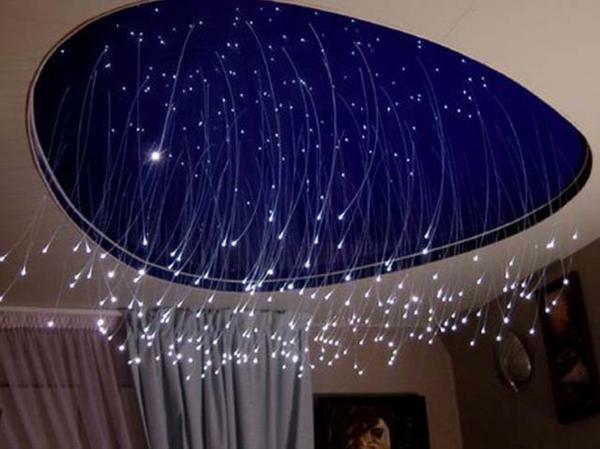 A starry sky from a plasterboard will light up any room. Ideal for children and bedrooms
A starry sky from a plasterboard will light up any room. Ideal for children and bedrooms
Starry sky on a plasterboard ceiling - an unusual design solution. You can make this decor element yourself. To do this, you need to select a suitable light generator, to which you will need to connect an optical fiber.
The process of manufacturing a starry sky on a gypsum board ceiling:
- First, attach a galvanized profile. To fix it it is necessary with the help of anchor dowels.
- Then attach to the surface of the suspension.
- Mount the ceiling profiles on the hangers.
- Fix the frame with self-tapping screws.
- We cut the plasterboard slabs.
- Drill holes in the tiles. They will be needed for the output of optical fibers.
- Insert optical fiber into the holes.
- Raise the plate and secure it with screws. Repeat this procedure until you cover the whole ceiling with the slabs.
- Then you need to put the putty on the ceiling.
- Next, proceed to surface painting.
- After the paint has dried, you need to pull the optical fiber 2-3 millimeters from under the drywall sheet.
- Fix the threads with glue.
If you do not want to use a light generator, you can make a starry sky with LED lights. They need to be installed in special holes, made in plasterboard sheets.
Thickness of plasterboard for ceiling( video)
When choosing a drywall, pay attention to the dimensions and materials from which the slabs are made. If you plan to install a plasterboard ceiling in rooms with high humidity, it is better to give preference to moisture resistant sheets. For the decoration of the living room or children's room, the usual drywall is suitable. Also, before you begin, decide on the type of ceiling. For the manufacture of single-level structures it is desirable to use a drywall with a small thickness, and for multi-level structures it is more than 9 millimeters thick plasterboard.
